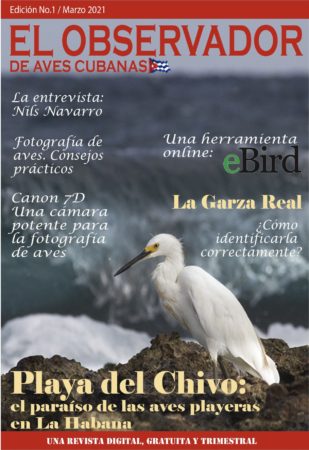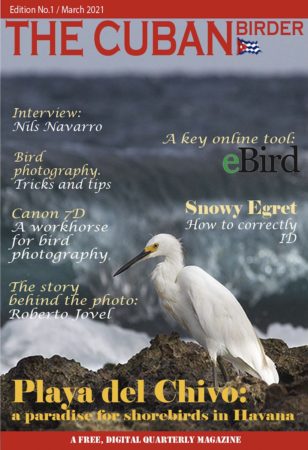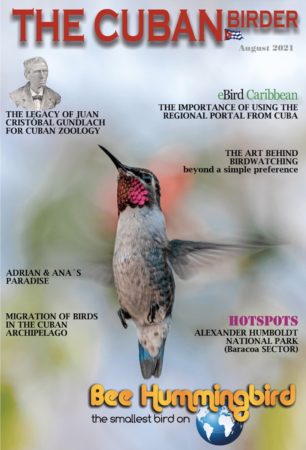 Are you looking for a good birding read? We recommend that you log on to “The Cuban Birder,” a quarterly, digital, free magazine, published in English and Spanish. Richly illustrated and packed with information, it is a gem of a publication for birders in all walks of life, and the first of its kind in Cuba. An initiative of Birding Havana, its third issue was released in August 2021, and it is supported by BirdsCaribbean.
Are you looking for a good birding read? We recommend that you log on to “The Cuban Birder,” a quarterly, digital, free magazine, published in English and Spanish. Richly illustrated and packed with information, it is a gem of a publication for birders in all walks of life, and the first of its kind in Cuba. An initiative of Birding Havana, its third issue was released in August 2021, and it is supported by BirdsCaribbean.
The magazine is more than just a substantial and fascinating read. The goal of the publication is simple: to get Cubans – especially the younger generations – excited about birds, so that they can take it up as a hobby. After all, Cuba has the highest number of recorded species in the insular Caribbean (397), of which around 262 are migratory. Once new devotees learn more and become engaged, this will lead to a deeper understanding of how the environment works, as well as a desire to protect and conserve the birds and the places where they live. In other words, it is hoped that the magazine will light a spark of awareness about Cuban birds and the serious, pressing challenges they face. The first issues have already received good readership.
The Cuban Birder has been a long-cherished dream of Birding Havana’s founding director Mr Vladimir Mirabal, former diplomat, lawyer, photographer and passionate birder. He says: “We have needed a magazine like this for a long time. There is great joy in birdwatching, and we want to express this through our publication. It is an educational tool that we hope will support our plans to rebuild a Cuban Birdwatchers Movement. Already, the Cuban Birders Club (Club de Observadores de Aves Cubanas) has experienced growth of over 3,000 new members in the past two months.” All who are seeking more information on Cuban birds and birding activities may join the Club’s Facebook page.
Helping to combat the caged bird threat
The magazine is especially timely as Cuba’s birds and nature face an uncertain future. The threats of climate change and habitat destruction loom large for Cuba, as they do for other Caribbean countries. Another significant threat is capturing and keeping wild birds to sell and keep as pets. Although illegal, this practice, long part of the culture, is growing among the Cuban population. Parrots, parakeets, grassquits, the Cuban Bullfinch, and many songbirds (residents, endemics, and migrants) are trapped, sold, and trained to compete in songbird competitions and kept as pets.
Fall migration is prime “hunting season” for the trappers and private Facebook groups in Cuba show off hundreds of migratory birds for sale, including Painted Buntings, Rose-breasted Grosbeaks, and dozens of warbler species. Even children are involved in the trapping. BirdsCaribbean will continue to assist with efforts to reduce these harmful behaviors by supplying birding gear and educational materials to help promote birding and develop Bird Clubs in each province. Bird watchers are a growing voice in Cuba. Vladimir commented, “With your support we will be able to reach out to a lot more people in our communities as part of our efforts to replace bird cages and traps with binoculars and field guides by increasing the appreciation for Cuban birds and supporting conservation efforts.” Many of our Cuban colleagues and partners have been working hard to educate and raise awareness about this issue for many years, but it remains a huge challenge. If you would like to donate to help us send binoculars and field guides to Cuba, please click here and select “Reducing bird trapping in Cuba” for your gift designation.
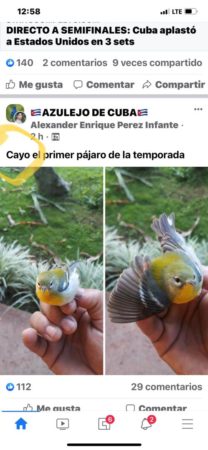

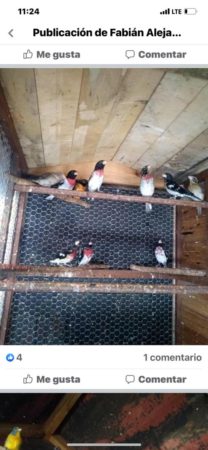
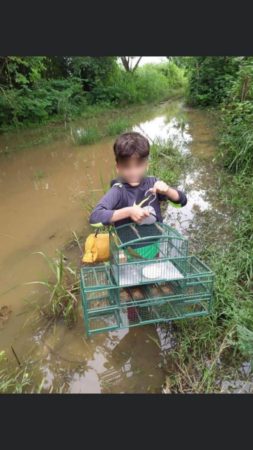
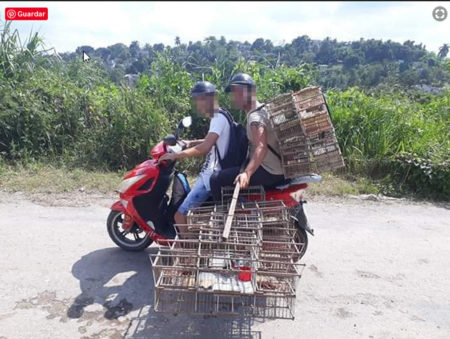
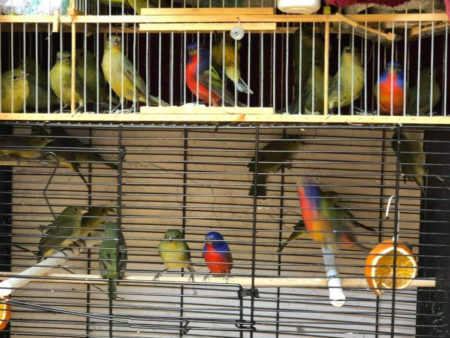
The legacy of Juan Cristóbal Gundlach in Cuba
So what will you find, as you turn the digital pages of this third issue of The Cuban Birder? If you love science history, you will enjoy browsing through articles on the life and work of Juan Cristóbal Gundlach (1810 – 1896), who was born in Germany but left a rich legacy in Cuban scientific discovery. The author of the first major work on Cuban ornithology, among other studies, his name is included in the Latin names of no less than sixty animal species – among the birds he discovered, these included the Gundlach’s Hawk and the Cuban Vireo.
According to a 1915 account, the avid collector and descriptor of thousands of species did not drink and was a frugal eater, often departing in the morning with a biscuit and a sandwich in his pocket – which he forgot to eat during the day. He was tall and reportedly had a bit of a limp, but he was quiet and unassuming, traveling from one end of the island to the other. What a dedicated man! You will enjoy getting to know Juan Cristóbal Gundlach better in the pages of the Cuban Birder. This fascinating section of the magazine, about a significant figure in Cuban natural history is illustrated with photographs of some of the birds he discovered, accompanied by his own descriptions.
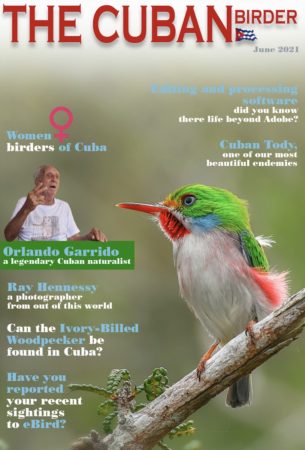 Don Juan, as he was known, was also the man who first discovered the smallest bird in the world – the Bee Hummingbird, which is the topic of another article in The Cuban Birder. Noting the tiny bird’s mating ritual, Gundlach noted, rather sweetly: “I have also seen the male when he is in love, go up perpendicularly with a non-progressive flight, sometimes singing, others not, stop, hover for a moment at the female, and then drop down.” Unfortunately, it is not as widely distributed as it was in Gundlach’s day, and is listed as Near Threatened on the IUCN Red List. You can read a detailed description of this exquisite but endangered bird in the magazine. On another page, there is a very useful fact sheet on Hummingbirds; there are some 343 species identified in the Americas, and they are surprisingly aggressive for their size!
Don Juan, as he was known, was also the man who first discovered the smallest bird in the world – the Bee Hummingbird, which is the topic of another article in The Cuban Birder. Noting the tiny bird’s mating ritual, Gundlach noted, rather sweetly: “I have also seen the male when he is in love, go up perpendicularly with a non-progressive flight, sometimes singing, others not, stop, hover for a moment at the female, and then drop down.” Unfortunately, it is not as widely distributed as it was in Gundlach’s day, and is listed as Near Threatened on the IUCN Red List. You can read a detailed description of this exquisite but endangered bird in the magazine. On another page, there is a very useful fact sheet on Hummingbirds; there are some 343 species identified in the Americas, and they are surprisingly aggressive for their size!
This is just a taste of what you can find in the latest issue of The Cuban Birder. It is an absorbing read that also includes helpful advice on the art of birdwatching and the best cameras for wildlife photography; as well as a gorgeous photo feature on the Alexander Humboldt National Park. A section on identifying hotspots using the Cornell Lab of Ornithology’s eBird Caribbean includes how to determine the criteria for a hotspot, and how to navigate the website to suggest one. This section also emphasizes the importance of using the portal, which is specially designed for the Caribbean – especially on days when there are special “counts,” such as the eleven-year-old Caribbean Waterbird Census (CWC) established by BirdsCaribbean. Data on Cuban birds – and our island birds in general – is more important than ever!
Previous issues have featured interviews with well-known Caribbean scientists like the legendary Orlando Garrido, and artist and naturalist, Nils Navarro, author of Field Guide to the Endemic Birds of Cuba. The magazine is also packed with tips on how to photograph birds, how to identify them, and places to visit and stay to enjoy Cuba’s amazing bird life.
We warmly recommend this digital magazine to our BirdsCaribbean members, and to anyone who wants to learn about and protect Cuba’s birds. We congratulate the editorial team and all the contributors, and hope that readers will share the publication widely online – including, of course, on social media. We eagerly look forward to the next issue of The Cuban Birder!
Here are some readers’ reviews:
José Eugenio Martínez González:
I have been very excited about this idea. You have given us a nice surprise. As a birder, which I have practiced alone or in the company of my family, without equipment, but with a lot of desire, I take my hat off to this initiative.
Daniela Ventura del Puerto:
Excellent! I hope this magazine contributes to more people leaving the cages and changing them for cameras and binoculars. Success in that work!
Alejandro Padrón:
Excellent work for Cuban nature. Congratulations to all the members of this Club. I will follow you with attention.
Agustín Dimas López Guevara:
What good news! Graphic showcase and sample of the work of this great team that brings to light, with image, nature; fauna and flora, beauties to appreciate.
Lázaro Ramón Sosa Morell:
Great initiative, something very worthy of the culture of respect in our country and the effort that so many people have made for years to make it so! Congratulations!
To get on the mailing list for this quarterly magazine, write to: birdinghavana@gmail.com
Download the August 2021 Issue – English
Download the August 2021 Issue – Spanish

